SSI Interface 7 - 5
ACK/NAK Disabled and Unpacketed ASCII Data
Data captured by the digital scanner is sent to the host.
Communication Summary
RTS/CTS Lines
All communication must use RTS/CTS handshaking as described in the Simple Serial Interface Programmer’s
Guide, p/n 72-40451-xx. If hardware handshaking is disabled or bypassed, the WAKEUP command must be
sent prior to all other communications, or the first byte of a communication message may be lost during the
digital scanner wakeup sequence.
ACK/NAK Option
Enable or disable ACK/NAK handshaking. This handshaking is enabled by default and Zebra recommends
leaving it enabled. Disabling this handshaking can cause communication problems, as handshaking is the only
acknowledgment that a message was received, and if it was received correctly. ACK/NAK is not used with
unpacketed decode data regardless of whether or not it is enabled.
Number of Data Bits
All communication with the digital scanner must use 8-bit data.
Serial Response Time-out
The Serial Response Time-out parameter determines how long to wait for a handshaking response before
trying again, or aborting any further attempts. Set the same value for both the host and digital scanner.
Retries
When sending data, the host should resend twice after the initial send if the digital scanner does not respond
with an ACK or NAK (if ACK/NAK handshaking is enabled), or response data (e.g., PARAM_SEND,
REPLY_REVISION). If the digital scanner replies with a NAK RESEND, the host resends the data. All resent
messages must have the resend bit set in the Status byte.
The digital scanner resends data two times after the initial send if the host fails to reply with an ACK or NAK (if
ACK/NAK handshaking is enabled).
Decoder
Data is captured
by decoder
Host
(1)
ASCII data sent
NOTE You can temporarily change the Serial Response Time-out when the host takes longer to process an ACK
or longer data string. Zebra does not recommend frequent permanent changes due to limited write cycles
of non-volatile memory.

